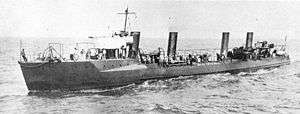USS Paul Jones (DD-10)
The second USS Paul Jones (DD-10) was a Bainbridge-class destroyer in the United States Navy. She was named for John Paul Jones.
 Shown in 1905 in the Pacific Ocean, USS Paul Jones (DD-10) was completed with a high forecastle for improved sea-keeping characteristics. The two set of stacks indicate that the boiler rooms are separated by their engine room, which should improve her survivability in a battle, as one hit would not disable all of her boilers. | |
| History | |
|---|---|
| Name: | Paul Jones |
| Namesake: | Captain John Paul Jones awarded Continental Congress Gold Medals |
| Builder: | Union Iron Works, San Francisco |
| Laid down: | 20 April 1899 |
| Launched: | 14 June 1900 |
| Sponsored by: | Mrs. Elizabeth Goldsborough Adams |
| Commissioned: | 19 July 1902 |
| Decommissioned: | 29 July 1919 |
| Stricken: | 15 September 1919 |
| Identification: |
|
| Fate: | Sold, 3 January 1920 |
| Status: | Broken up for scrap |
| General characteristics [1] | |
| Class and type: | Bainbridge-class destroyer |
| Displacement: |
|
| Length: | |
| Beam: | 23 ft 7 in (7.2 m) |
| Draft: | 6 ft 6 in (2.0 m) (mean) |
| Installed power: | |
| Propulsion: |
|
| Speed: | 29 kn (54 km/h; 33 mph) (designed speed) |
| Complement: |
|
| Armament: |
|
Construction
Paul Jones was laid down on 20 April 1899, by the Union Iron Works of San Francisco; launched on 14 June 1902; sponsored by Mrs. Elizabeth Goldsborough Adams; and commissioned on 19 July 1902, Lieutenant R. F. Gross in command.
Originally built as a torpedo boat destroyer, Paul Jones served in the Pacific Fleet, homeported at San Francisco. A unit of the Pacific Torpedo Fleet, she was at San Francisco at the beginning of World War I.
World War I
Paul Jones sailed on 23 April 1917, for Norfolk, Virginia, via San Diego, Acapulco, the Panama Canal Zone, and Guantanamo Bay, Cuba, arriving on 3 August. On 4 August, she took station off the York River on patrol assignment until joining Duncan, Henley, Truxtun, Stewart, Preble, Hull, Macdonough, and Hopkins as escorts for Battleship Force, Atlantic Fleet, on 13 August, for passage to Bermuda and New York.
Paul Jones departed the Brooklyn Navy Yard on 24 August and reported to Newport, Rhode Island where she began a series of convoy patrols up and down the coast and returning to Newport on 24 September. She then commenced training operations, in conjunction with other duties, off Norfolk, Lynnhaven Roads, and Chesapeake Bay, prior to reporting to Philadelphia on 20 December.
On 15 January 1918, in company with Stewart, Hopkins and Worden, Paul Jones sailed for the Azores by way of Bermuda. After departing Bermuda, she had to request permission to turn back due to a serious leak in her port after bunker. From 23–26 January, Paul Jones' crew struggled against great odds and succeeded in saving the ship from sinking. Wallowing in stormy seas with her after fire room flooded, barely able to maintain headway, having lost all drinking and feed water and steaming under two boilers with salt feed, manning bucket brigades for lack of operable pumps, and receiving no answers to her distress signals, she finally sighted a light off St. David's Head, Bermuda, signalled the fort for assistance and dropped her anchor.
Paul Jones remained at Bermuda until 22 February for repairs and then sailed for Philadelphia escorted by Mars arriving on 25 February. Following permanent repairs at the Philadelphia Navy Yard, Paul Jones reported to Fortress Monroe, Virginia on 18 April, and performed various duties in and around Chesapeake Bay until 6 August.
The highlight of Paul Jones' career came on 2 July when Henderson was on fire in the Atlantic north of Bermuda and east of Virginia. Paul Jones made four trips from the burning ship to Von Steuben saving 1,250 Marines and officers together with over 50 tons of luggage. The next day she accompanied Henderson to Delaware Breakwater.
While in convoy on 7 August at sea, Paul Jones with several other ships in her group mistook O-6 for an enemy submarine and fired upon her. The submarine was struck seven times in the conning tower before the mistake was apparent. Paul Jones escorted the damaged submarine to Delaware Bay, and arrived at the breakwater the following day.
Paul Jones reported at Hampton Roads on 9 August and remained in and around Chesapeake Bay conducting mine patrols, convoy duties and other services until slated for inactivation on 31 January 1919. She decommissioned on 29 July; was struck from the Naval Vessel Register on 15 September; and was sold on 3 January 1920 to Joseph G. Hitner, Philadelphia, who subsequently scrapped her.
Noteworthy commanding officers
- Lieutenant Edgar Brown Larimer (15 January 1907-11 July 1907) (Later Rear Admiral and Chief of the Bureau of Ordnance (1931-1934))
- Lieutenant William A. Glassford(September 1911-May 1912, 1 February 1916-October 1916) (Later Vice admiral)
- Lieutenant Leo Hewlett Thebaud (1918-29 July 1919) (Later Vice admiral)
Notes
- "USS Paul Jones (DD-10)". Navsource.org. Retrieved June 13, 2015.
This article incorporates text from the public domain Dictionary of American Naval Fighting Ships. The entry can be found here.